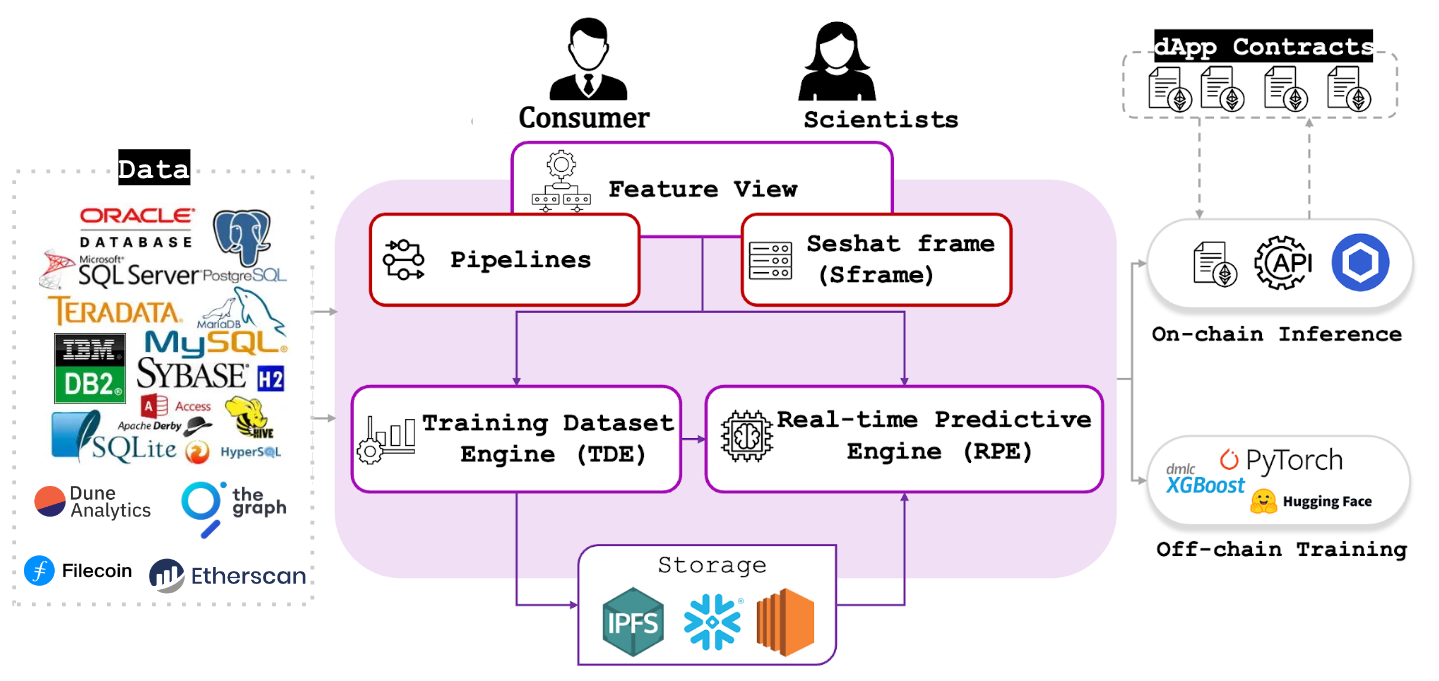Welcome to Seshat
Welcome to Seshat, the foundational Web3 protocol for decentralized machine learning dataflow management. As machine learning evolves, so does the necessity for advanced, scalable, and secure data engineering—especially within decentralized Web3 ecosystems. Seshat is uniquely designed to redefine data engineering across multiple domains, ensuring data consistency, security, and robust infrastructure for future machine learning applications.
Mission
Our mission at Seshat is to revolutionize data engineering for machine learning by eliminating the centralization of traditional data management systems. By implementing a decentralized approach, we aim to enhance security, improve data integrity, and foster a trustless environment for developing and deploying machine learning models.
Key Challenges in Data Engineering
The development of machine learning models in Web3 presents unique challenges, which Seshat aims to address:
- Data Handling and Processing: The decentralized nature of data sources in Web3 complicates the data handling and preprocessing that is essential for machine learning.
- Scalability and Efficiency: Traditional centralized systems often lead to scalability bottlenecks and inefficiencies. Seshat's decentralized network leverages distributed resources to enhance scalability and operational efficiency.
- Security and Privacy: Ensuring data integrity and security in a decentralized environment is paramount. Seshat's protocol incorporates advanced cryptographic methods to maintain privacy and security throughout the data lifecycle.
Seshat- A decentralized ML dataflow
The key to enhanced scalability, efficiency, and robust security lies in decentralization. By leveraging idle resources across a distributed network, Seshat eliminates the bottlenecks associated with centralized data management systems, thereby democratizing access to computational power and storage.

While platforms like Gensyn and Ritual focuns on the Infrastructure and Model Layer, providing robust environments for model specialization and edge intelligence, and others such as TheGraph and Chainlink manage the Data Layer with their capabilities in data acquisition and decentralized storage, there remains a pivotal gap. This gap exists in the seamless integration and management of ML dataflows—a middle layer essential for bridging data handling with model application.
Seshat introduces a comprehensive framework specifically designed to address this gap. By deploying a decentralized protocol that manages the flow of machine learning data from acquisition through processing to application, Seshat ensures that data is not only ingested but also effectively transformed and made readily available for real-time decision-making and model training.
Leveraging Idle Resources Across the Network
Seshat’s approach to decentralization utilizes idle computational and storage capacities within the network, optimizing resource allocation, and reducing associated costs. This enhances the entire machine learning process from the ground up:
- Data Layer: Facilitates robust, secure data acquisition and storage.
- ML Dataflow Layer: Where Seshat adds significant value, ensuring that data transitions smoothly between the offline training and online inference phases, effectively managing the lifecycle of data as it becomes information.
- Infra & Model Layer: While often handled by other platforms, Seshat ensures compatibility and integration, enhancing these functionalities with streamlined dataflows.
- Application Layer: Empowers developers and businesses by providing easy access to processed, actionable data for a variety of applications from AI development tools to consumer-facing apps.
To tackle these challenges, Seshat employs a comprehensive decentralized framework that manages the entire lifecycle of data from acquisition to real-time inference.

Data Ingestion and Preprocessing
- Automated Data Ingestion: Streamlined processes to ingest and preprocess data from both Web2 (i.e., AWS, Azure) and Web3 (i.e., The Graph, Dune, FlipSide) sources efficiently.
- Data Transformation: Utilizing pre-verified dataflow featuresto transform raw data into a structured format ready for machine learning.
Machine Learning Model Lifecycle
Facilitating the training phase with prepared datasets ready for algorithmic learning and ensuring minimal latency for real-time inference. This process is supported by nodes specialized for each task:
- Training Data Providers: Nodes equipped with the Seshat SDK automate the collection and preprocessing of training data, ensuring it is in the ideal format for machine learning models.
- Inference Data Providers: Similarly, nodes using the Seshat SDK manage real-time data needs, preparing and supplying data instantly as required by deployed models for accurate and timely decision-making.
Benefits of Using Seshat
- Cost Savings: Our analysis shows that using the Seshat Protocol for ML dataflow can save around 70% of costs compared to centralized providers like AWS SageMaker.
- Enhanced Data Integrity and Security: Through the use of blockchain technology, data processed via Seshat is secured against unauthorized access and tampering.
- Reduced Reliance on Centralized Systems: By distributing data management tasks across a decentralized network, Seshat reduces the cost and inefficiency associated with centralized infrastructures.
- Scalability and Responsiveness: The decentralized nature of Seshat allows for scalable solutions that adapt to the growing demands of machine learning applications in real time.
Seshat stands at the forefront of integrating blockchain technology with machine learning dataflow management, providing a robust, efficient, and secure platform for the next generation of decentralized applications.